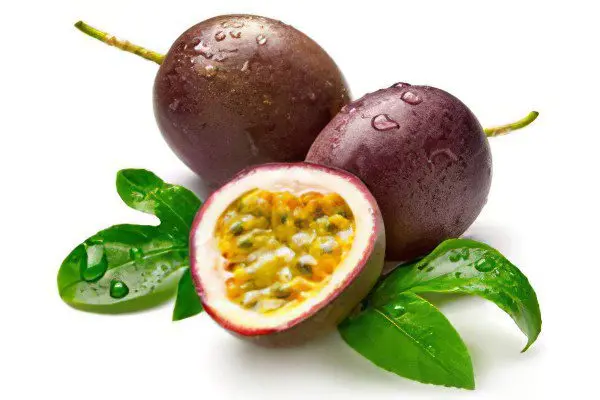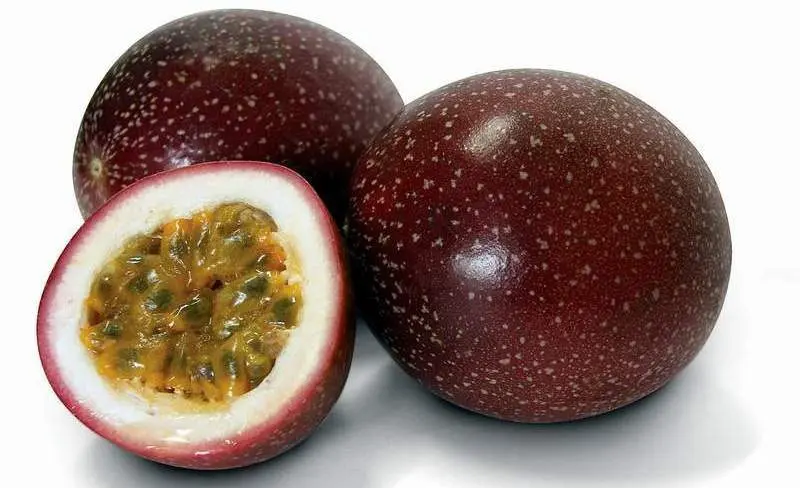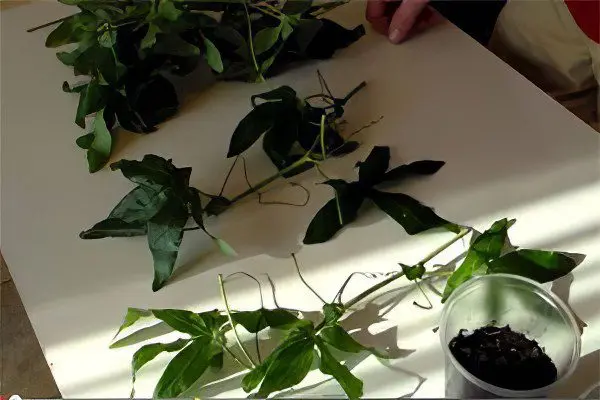Contents
This exotic fruit is cultivated on an industrial scale in South Africa, Australia, the Hawaiian Islands, Thailand, South America, although its homeland is the tropics of Brazil.
In Russia, passion fruit is known under the name “passiflora”, “passion flower”, “granadilla”. There is a legend that the Italian Jesuit monk F. Ferrari called this plant a passion flower in memory of the sufferings of Jesus Christ. When he was shown a passionflower flower, he compared parts of the plant to garments, the wounds of the Savior, the crown of thorns and nails from his crucifixion.
In its homeland, in tropical forests, passion fruit grows on strong vines of almost ten meters in length with dark green leaves. There are dozens of varieties of this species. Passion fruit flowers are not very large, after pollination in 80 days a fragrant fruit is formed in place of the flower.
Composition of passion fruit

100 g of passion fruit contains:
Water – 78 g
Proteins – 2.4 g
Fats – 0.4 g
Carbohydrates – 13.4 g
Dietary fiber (fiber) -1.5 g
Vitamins:
Vitamin A (beta-carotene) – 0.24 mg
Vitamin V1 (thiamine) – 0.02 mg
Vitamin B2 (riboflavin) – 0.1 mg
Niacin (vitamin B3 or vitamin PP) – 2.5 mg
Vitamin B5 (pantothenic acid) – 0.2 mg
Vitamin B6 (pyridoxine) – 0.4 mg
Folic Acid (Vitamin B9) 14 mcg
Vitamin C (ascorbic acid) – 24 mg
Vitamin E (tocopherol) – 0.4 mg
Biotin (vitamin H) – 5 mcg
Vitamin K (phylloquinone) – 10 mcg
Macronutrients:
Potassium – 340 mg
Calcium – 17 mg
Magnesium — 9 mg
Sodium – 28 mg
Sulfur – 19 mcg
Chlorine – 37 mg
Phosphorus – 57 mg
Trace elements:
Iron – 1.3 mg
Iodine – 1.3 mcg
Manganese – 120 mcg
Copper – 120 mcg
Zinc – 0.25 mg
Fluorine – 20 mcg
What does passion fruit look like?
Those who have never seen a passion fruit can imagine a large yellow or dark purple plum. This exotic fruit grows on a vine, its length varies from 6 to 12 cm. Passion fruit, which is not quite ripe, has a smooth skin, and its ripe fruit is distinguished by a wrinkled surface. The peel of the fruit is quite dense, it reliably preserves the pulp from mechanical damage.

Useful properties of passion fruit
The composition of passion fruit contains almost no fat, protein and carbohydrates predominate, which allows those who care about their weight to use this fruit in their diet. Calorie content of 100 g of tropical delicacy is only 65-70 kcal. But the benefits of passion fruit are not only used in dietary nutrition, it has many valuable properties.
Useful properties of passion fruit:
Strengthening immunity – vitamins and antioxidants in the composition of this fruit neutralize free radicals, carrying out a kind of prevention of viral infections, increases the body’s resistance.
Cancer prevention – flavonoids, phenols, vitamins A and C have an anti-carcinogenic effect, activating white blood cells, eliminating free radicals.
Prevention of ophthalmic diseases – even small portions of regularly consumed passion fruit will strengthen the health of the eyes, serve as an excellent prevention of degeneration of the organ of vision, cataracts and night blindness.
Improvement of the skin, elimination of wrinkles, normalization of the condition of the epidermis – masks and scrubs from this fruit are very effective due to vitamin A, which is abundant in passion fruit.
Benefits for the intestines – the abundance of fiber contained in this fruit perfectly stimulates the intestines. Digestion of food, fighting constipation, removing toxins, balancing blood sugar – these properties of passion fruit effectively regulate digestion processes.
Normalization of blood pressure – with the regular use of this fruit, a pronounced vasodilating effect is felt, which normalizes blood pressure for a long time.
An adjuvant for cardiac pathologies – an abundance of potassium, copper, iron supports the work of the heart muscle, improves blood circulation.
Prevention of insomnia – the abundance of macro- and microelements in the composition of the fruit pulp helps to improve the condition of bone tissue, increase its density and strength. The use of passion fruit is recommended for the prevention of age-related osteoporosis, relieving joint inflammation, and reducing pain.
In addition, passion fruit relieves headaches and menopausal symptoms, helps with insomnia, promotes the beauty of nails and hair, and slows down the aging process.
What does passion fruit taste like?
At full maturity, passion fruit is juicy and sweet, and contains 40% juice. There are many opinions about what passion fruit tastes like. To some, it resembles kiwi, to others – ripe sea buckthorn. Most often, the taste of yellow-orange pulp resembles a mixture of flavors and aromas of strawberries, plums, apricots, peaches, gooseberries. This fantastic mixture leaves no one indifferent. To feel this bouquet, you need to acquire a ripe, heavy fruit with a wrinkled skin.
How do you eat passion fruit?
The thick skin of the passion fruit is not edible and is discarded after consumption. In the homeland of this exotic plant, it is customary to eat the pulp with a spoon, choosing it from half of the fruit. To do this correctly, with the least loss of valuable juice, you need to cut the passion fruit peel in a circle, trying to make a cut so as not to cut the fruit in half. After that, the halves are separated with a quick movement, trying not to lose a drop of refreshing juice. Passion fruit seeds are edible and are eaten along with the pulp.
The pulp of this fruit is widely used in cooking in countries where it is traditionally grown. It is added to salads, mousses, pie fillings, sauces. Edible passionfruit seeds in Brazil are used to decorate confectionery. It is believed that after eating a cake or a cake with such decoration, a person becomes calmer. The tonic juice of this fruit is drunk undiluted, added to cocktails and other drinks.
Growing passion fruit at home

If desired, passion fruit can be grown at home, in a short time it will braid a large space with its shoots and begin to bloom with amazingly beautiful flowers. Of course, its shoots will not reach ten meters in length, like the passion fruit vines in the tropics of Brazil, however, this plant will decorate the interior with bright greenery, amazingly beautiful unusual flowers and, possibly, will bear fruit.
There are two types of reproduction:
seed,
With the help of cuttings.
For cuttings, you need to have an adult fruiting passion fruit plant on hand. The easiest way to get your own copy is by seed propagation. Planting material can be purchased at a specialty store, where the seeds are most likely sold under the trade name “passiflora” or extracted from a ripe fruit yourself. Washed and dried seeds must be disinfected by washing them in a weak solution of soda or potassium permanganate.
The components of the growing soil are also roasted for an hour in the oven or for 15-20 minutes in the microwave to prevent the tropical sissy from becoming infected with fungal diseases to which it is not immune.
Soil composition:
Humus – 1 part;
Coarse river sand – 1 part,
Sod land – 2 parts.
Seeds are placed in nutrient soil, lightly sprinkled with earth, shed the soil and covered with a film until germination. They will have to wait quite a long time – at least a month. All this time, the soil is ventilated, slightly opening the film, and kept moist. It is necessary that the container was in a bright place at a temperature not lower than room temperature.
Care for passion fruit after germination:
Placement of the plant – only in a bright place, devoid of drafts. If the plant is on the windowsill, it is not recommended to open either the window or the window.
Watering – only as needed, after the topsoil has dried.
Top dressing – every 15 days with complex fertilizer, fertilizers for tomatoes are excellent, foliar spraying with stimulants such as “Epin”, “Zircon” is welcome in accordance with the instructions.
Passion fruit support is extremely necessary, since in a few months this plant is able to completely close the window opening with its shoots. It should be noted that this vine is practically unable to grow if its shoots are directed downwards or tied with twine. The best option is a strong support in the form of a trellis or a special lattice.
Transplantation – carried out in the phase of 3-4 true leaves immediately into a pot in which the plant will spend its life. If the passion fruit is not transplanted at this point, it will be technically more difficult to do later due to the abundant vegetative mass of the shoots.
Pollination – carried out manually with a soft brush. The best time for this operation is the first half of the day, the air humidity must be at least 65%, otherwise the pollen loses its ability to pollinate.
With careful implementation of all technological operations, the first fruits will delight after the first year of growing passion fruit. But, even if this does not happen, exotic flowers and abundant greenery will become the pride of the grower.
Contraindications to the use of passion fruit
With extreme caution, this fruit should be consumed by those who have experience in dealing with any allergic manifestations. Extremely rare, but still there is an individual intolerance to exotic fruits. Passion fruit should not be used to feed young children. Even if the child does not have a tendency to allergies, the baby’s immature gastrointestinal tract can react in the most extraordinary way.
Persons suffering from diabetes should be aware that when passion fruit is stored in a cool place for a long time, the amount of sugar in them increases significantly. Particular attention should be paid to the thorough cleaning of fruits purchased in the distribution network, since for the preservation of fruits during long-term transportation, they are treated with wax and antibacterial drugs. It is desirable that these funds do not enter the body during meals.
The use of passion fruit will bring many benefits to exotic fruit consumers. Its rich composition normalizes many functions of the body, positively affects the condition of the skin, nails, hair, and growing this plant at home will bring a lot of pleasant experiences.









